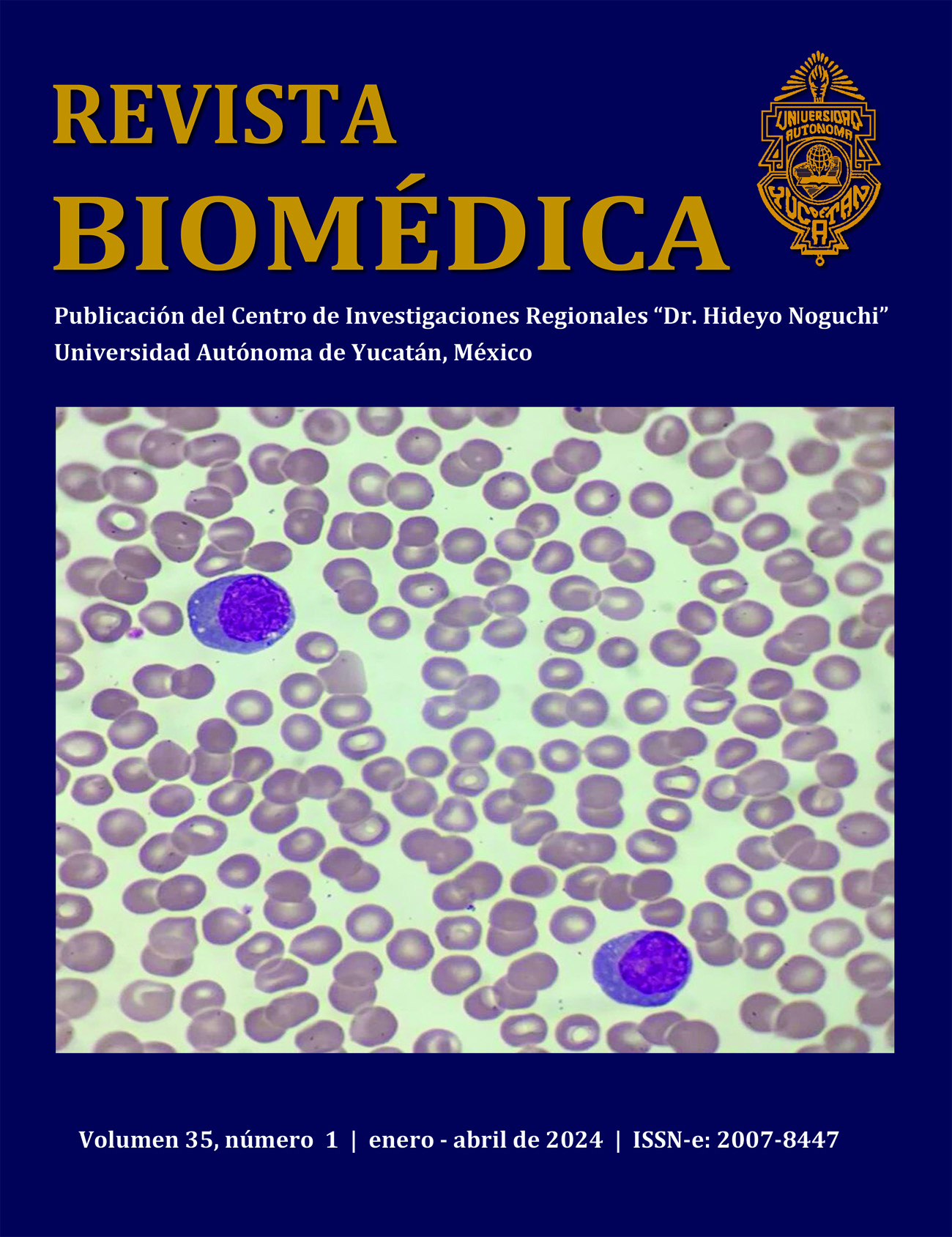Actividad de enzimas antioxidantes eritrocitarias en una muestra de adultos jóvenes y mayores del Valle Central, Costa Rica
Resumen
Introducción. El daño oxidativo provocado por los radicales libres de oxígeno está relacionado con el proceso de envejecimiento, diversas patologías y el estilo de vida de las personas, pero en el organismo existen defensas enzimáticas antioxidantes que confieren una debida protección.
Objetivo. Determinar la actividad enzimática de la glucosa-6-fosfato deshidrogenasa (G6PD), la catalasa (CAT) y la NADH metahemoglobina reductasa (NADH-MR), en una población costarricense de adultos jóvenes y mayores, para establecer el intervalo de referencia y evaluar el efecto de algunas condiciones en donde se presenta daño oxidativo.
Materiales y métodos. Se determinó la actividad enzimática en una población de 110 individuos entre los 19 y 95 años, utilizando el método propuesto por Ernest Beutler. Se estableció el intervalo de referencia de la población y se evaluó el efecto de la edad, patologías de fondo y el fumado, mediante estadística descriptiva.
Resultados. Conforme avanza la edad las enzimas NADH-MR y la CAT disminuyeron su actividad eritrocitaria y la G6PD no presentó cambios significativos. No se encontró evidencia de un cambio significativo en la actividad enzimática con respecto al hábito de fumado y las condiciones patológicas estudiadas.
Conclusiones. Es necesario realizar más investigación en cuanto a factores ambientales y del estilo de vida que influyen en la actividad enzimática antioxidante. El tamaño de las poblaciones, la ausencia de métodos estandarizados y las condiciones del ensayo pueden afectar los resultados y su grado de significancia. Por lo tanto, deben estandarizarse las metodologías, de manera que en futuros proyectos se evalúen los resultados de acuerdo con estas condiciones.
Palabras Clave: Glucosa-6-fosfato deshidrogenasa, NADH metahemoglobina reductasa, Catalasa.
Referencias
Halliwell B. Reactive species and antioxidants. Redox biology is a fundamental theme of aerobic life. Plant Physiol. 2006 June; 141(2): 312-22. https://doi.org/10.1104/pp.106.077073
Halliwell B. Biochemistry of oxidative stress. Biochem Soc T. 2007 Oct; 35(5): 1147-50. https://doi.org/10.1042/BST0351147
González E, Vaillant F, Rojas G, Pérez A. Novel semiautomated method for assessing in vitro cellular antioxidant activity using the light-scattering properties of human erythrocytes. J Agr Food Chem. 2010 Jan; 58(3): 1455-61. https://doi.org/10.1021/jf903467x
Amari F, Fettouche A, Samra MA, Kefalas P, Kampranis SC, Makris AM. Antioxidant small molecules confer variable protection against oxidative damage in yeast mutants. J Agr Food Chem. 2008 Feb; 56(24): 11740-51. https://doi.org/10.1021/jf802829r
Siti HN, Kamisah Y, Kamsiah J. The role of oxidative stress, antioxidants and vascular inflammation in cardiovascular disease (a review). Vasc Pharmacol. 2015 Aug; 71: 40-56. https://doi.org/10.1016/j.vph.2015.03.005
Halliwell B, Whiteman M. Measuring reactive species and oxidative damage in vivo and in cell culture: how should you do it and what do the results mean?. Brit J Pharmacol. 2004 May; 142(2): 231-55. https://doi.org/10.1038/sj.bjp.0705776
Beutler E. Red Cell Metabolism: A Manual of Biochemical Methods. New York, USA: Grune and Stratton; 1984.
Sáenz GF, Moreira J. Laboratorio Hemoglobinopatías: Manual Latinoamericano. San José, Costa Rica: Ministerio de Salud Pública; 1980.
Kennett EC, Ogawa E, Agar NS, Godwin IR, Bubb WA, Kuchel PW. Investigation of methaemoglobin reduction by extracellular NADH in mammalian erythrocytes. Int J Biochem Cell Biol. 2005 Jul; 37(7): 1438-45. https://doi.org/10.1016/j.biocel.2005.02.001
Lukyanenko LM, Kozlova NM, Slobozhanina EI. Activity of membrane-bound NADH-methemoglobin reductase and physical state of lipids in erythrocyte membranes. Bioelectrochemistry. 2004 May; 62(2): 191-93. https://doi.org/10.1016/j.bioelechem.2003.09.005
Bridges KR & Pearson HA. Anemias and other red cell disorders. USA: McGraw-Hill Companies; 2008. https://doi.org/10.1036/0071419403
Pandey KB & Rizvi SI. Markers of oxidative stress in erythrocytes and plasma during aging in humans. Oxid Med Cell Longev. 2010 Feb; 3(1): 2-12. http://dx.doi.org/10.4161/oxim.3.1.10476
Kasapoglu M & Özben T. Alterations of antioxidant enzymes and oxidative stress markers in aging. Exp Gerontol. 2001 Feb; 36(2): 209-20. https://doi.org/10.1016/S0531-5565(00)00198-4
Jozwiak Z & Jasnowska B. Changes in oxygen-metabolizing enzymes and lipid peroxidation in human erythrocytes as a function of age of donor. Mech Ageing Dev. 1985 Oct; 32(1): 77-83. https://doi.org/10.1016/0047-6374(85)90037-5
Guemouri L, Artur Y, Herbeth B, Jeandel C, Cuny G, Siest G. Biological variability of superoxide dismutase, glutathione peroxidase, and catalase in blood. Clin Chem. 1991 Nov; 37(11): 1932-37. https://www.ncbi.nlm.nih.gov/pubmed/1934468
Barnett YA & King CM. An investigation of antioxidant status, DNA repair capacity and mutation as a function of age in humans. Mutat Res-DNAging. 1995 Oct; 338(1-6): 115-28. https://doi.org/10.1016/0921-8734(95)00017-Z
Andersen HR, Nielsen JB, Nielsen F, Grandjean P. Antioxidative enzyme activities in human erythrocytes. Clin Chem. 1997 Apr; 43(4): 562-68. https://www.ncbi.nlm.nih.gov/pubmed/9105255
Harman D. Aging: a theory based on free radical and radiation chemistry. J Gerontol. 1956 Jul; 11(3): 298-300. https://doi.org/10.1093/geronj/11.3.298
Öztürk O & Gümüşlü S. Changes in glucose-6-phosphate dehydrogenase, copper, zinc-superoxide dismutase and catalase activities, glutathione and its metabolizing enzymes, and lipid peroxidation in rat erythrocytes with age. Exp Gerontol. 2004 Feb; 39(2): 211-216. https://doi.org/10.1016/j.exger.2003.10.015
Kletzien RF, Harris PK, Foellmi LA. Glucose-6-phosphate dehydrogenase: a" housekeeping" enzyme subject to tissue-specific regulation by hormones, nutrients, and oxidant stress. FASEB J. 1994 Feb; 8(2): 174-81. https://www.ncbi.nlm.nih.gov/pubmed/8119488
Acosta-Sánchez T, Núñez D, Suárez-Luengo M. Anemia hemolítica por deficiencia de G6PD y estrés oxidativo. Rev Cubana Invest Biomed. 2003 Sep; 22(3): 186-91. http://scielo.sld.cu/scielo.php?script=sci_arttext&pid=S0864-03002003000300007
Cross CE, van der Vliet A, Eiserich JP. Cigarette smokers and oxidant stress: a continuing mystery. Am J Clin Nutr. 1998 Feb; 67(2): 184-5. http://ajcn.nutrition.org/content/67/2/184.extract
Dieterich S, Bieligk U, Beulich K, Hasenfuss G, Prestle J. Gene expression of antioxidative enzymes in the human heart increased expression of catalase in the end-stage failing heart. Circulation. 2000 Jan; 101(1): 33-39. https://doi.org/10.1161/01.CIR.101.1.33
Shull S, Heintz NH, Periasamy M, Manohar M, Janssen YM, Marsh JP, et al. Differential regulation of antioxidant enzymes in response to oxidants. J Biol Chem. 1991 Dec; 266(36): 24398-403. https://www.ncbi.nlm.nih.gov/pubmed/1761541
Johnson P. Antioxidant enzyme expression in health and disease: effects of exercise and hypertension. Comp Biochem Phys C. 2002 Dec; 133(4): 493-505. https://doi.org/10.1016/S1532-0456(02)00120-5
Enlaces refback
- No hay ningún enlace refback.













